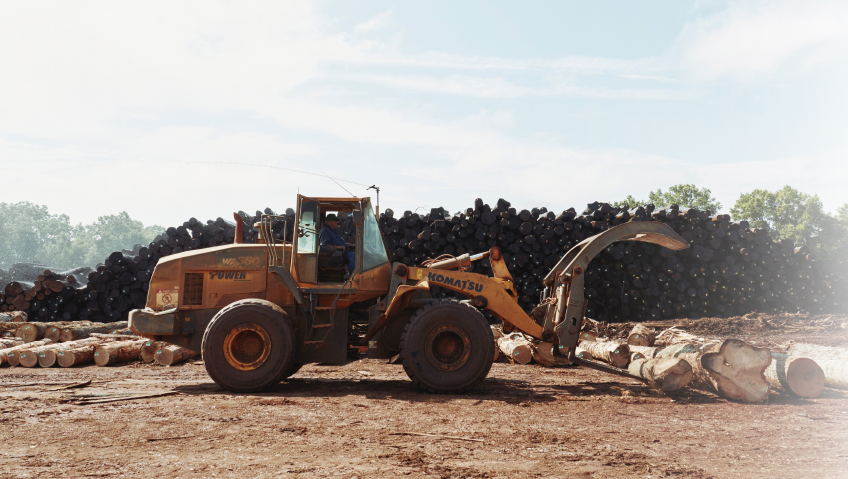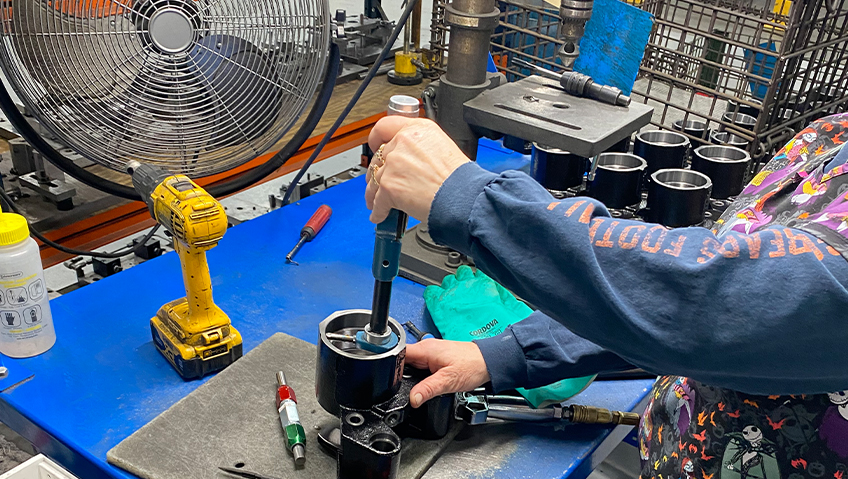While sustainability may not be the first word that comes to mind when talking about the forestry industry, for Thompson Appalachian Hardwoods, sustainability does come first.
Dedication to full-forest utilization, efficient manufacturing, and responsible forest management has propelled the company into strongly competing along the forest products supply chain as a sustainable producer of quality hardwood lumber, industrial products, and wood biomass.
Established in 1993, family-run Thompson Appalachian Hardwoods started as a small green sawmill and has since expanded to a full-service forest products company with a fully functional sawmill, dry kilns, concentration yard, planer mill, and extensive timber procurement program.
The family roots run deep. Founded by Nordeck and Mary Claire Thompson in Huntland, Tennessee, following in the footsteps of his father, W.N. “Bill” Thompson Sr., Nordeck has kept the business in the family, employing three of his six children, including daughter and CFO Claire Getty.
Growing through challenges
“My granddad helped my dad capitalize the business as they got started, and since then it’s been a slow and steady methodical grind every day to do the best we could for that day, but also looking forward to see what could happen next,” Getty says. That approach means not regarding issues that arise as problems, but rather taking them as opportunities and striving to meet them.
“We’ve done that over the last 30 years,” she says. “The basis of it is being in a place with high-quality raw material—privately owned timberland—putting it out and expanding and growing through challenges to the next thing.”
For Thompson, seizing opportunities has also included starting its own trucking company, Thompson Transport, to move its products to and from its mills and avoid the problems that come with relying on third party providers.
“Looking back, my dad knew he needed to do something that would get him further down the supply chain so he wasn’t so reliant on others to get his products,” Getty explains. The company has also invested in a dry kiln facility and a logging company with two crews, more instances of how overcoming obstacles and challenges can catapult a company forward.
A sustainable industry
One ongoing challenge as a forest products company is dealing with the misconception of the sustainability of the industry, Getty adds.
“We get asked every day if we’re running out of trees, if we’re cutting down too many trees,” she says. “But we’re committed to educating people on the importance of the working forest and how it’s imperative for us to have sustainable building products coming from wood by maintaining the economic value of standing forest.”
When you’re a landowner, she adds, you have to think about why you own this land, what its value is, and what you can do with it. “Also, what can my future generations do with this land?” Getty says. “We want lands to stay forests; we do not want lands to have permanent land use conversion. People don’t realize that when you take a 200-acre tract and subdivide it into mini farms, you’ve completely taken out that rotational, working forest.”
Going a step further, when you clear land for stores and parking lots, those places will never grow trees again and never positively impact the environment.
“If we don’t maintain the economic value of timberland, people will choose other things to do with it and it will cease to be timberland,” Getty says. “We’re able to provide a 40-to-50-year economic cycle for families to keep forestland intact, to keep them in their family’s portfolio, and to have a monetization and reward for doing a good thing, which is growing the Earth’s forests and maintaining natural carbon sequestration systems. That’s our main point.”
The next step is intentionally being the best stewards and practitioners of harvesting the woods that they can be. To that end, all of Thompson Appalachian Hardwood’s loggers and procurement agents utilize best management practices, flag property lines, know where the streams are, and sustainably manage and harvest to maintain the area’s optimum ecology.
And while people don’t like clear-cuts, Getty says, they can be very good for the forest, as opposed to simply cutting all the good trees and leaving the bad ones. “At that point, it can be best just to go in and clear everything and let everything grow back, because the best trees are what come back afterward,” she says, adding that young trees actually sequester more carbon and are more productive from a climate perspective than aged forests that have reached peak maturity and are showing signs of mortality.
The result, she says, is that, “as a company and as a forest industry, we’re able to go into those forests when the trees have reached peak maturity and peak value for the landowner.”
Trees at the very southern tip of the Appalachian Mountains, where the company is located, begin to deteriorate from the inside when they start dying. When they fall, they emit all the carbon they’ve sequestered. Thompson Appalachian Hardwoods harvests the trees and creates a solid product that will store that carbon indefinitely.
“Those products are natural carbon storage solutions in a time where we’re all looking for ways to reduce our footprints and store carbon,” Getty says. “We’re all about optimizing the yield and making the most we can of these trees. We don’t want waste, and the waste we do have we can use as biofuel.” Other biofuel byproducts that come from cutting logs into lumber include bark, sawdust, and wood chips, all of which will be burned to generate energy.
In another sustainable initiative, the company recently installed a 600 hp biomass boiler, paid for in part by the USDA Rural Energy for America program and the U.S. Forest Service Wood Innovation Grant program. The boiler assists with turning waste products into steam to run all the company’s dry kilns, eliminating the need to have propane trucked in weekly.
“We produce a product that will burn and create energy,” Getty says. “That’s one of the steps we’ve taken to be a zero waste facility, and we actually burn our byproducts to create energy.”
Boosting safety, managing risk
The company also takes safety seriously, ensuring all employees are trained properly in all areas of the job, and is dedicated to creating a positive company culture.
“We also do a lot of internal training now, which is another area that we’ve invested in,” Getty shares. “We’re tired of everybody talking about how awful it is to hire people and how ‘nobody wants to work and everybody’s lazy’ and so on; it’s not true. Everybody who says that needs to reflect on what kind of jobs and businesses they’re running and whether they’re actually a good place to work.”
For Thompson Appalachian Hardwoods, this has included investing in a full-time Human Resources Manager to help recruit and retain top people, maintain a culture of safety, and create pathways for advancement, all efforts that have helped create a more stable workforce.
Getty is also proud of the company’s improved risk management program. 15 years ago when involved in logging and sawmilling—considered the top most dangerous job by OSHA—the company was expensing its significant insurance premiums, whether for property, casualty, or general liability. “Yes, people had to wear hard hats, but we weren’t going over and beyond in our safety culture,” she says. “We were just doing what we needed to do.”
The company learned that making risk management a primary focus of the business would result in reduced claims and reduced premiums, and it would actually become a revenue stream and investment opportunity with eligibility for alternative insurance opportunities, Getty says. “We started investing on the front end—in risk management, safety committees, safety training, regular internal safety audits, and pre- and post-accident screenings,” she says.
Steady improvement resulted in acceptance into a captive insurance program, so now instead of writing monthly checks, it’s simply a part of doing daily business.
“Now we’re investing not only on the ground in the different ways that we handle risk in our plants but also in how the premium dollars are spent: it’s going into a pool. If we don’t use it, we get the money back,” Getty says. “We got a 30 percent reduction in our premiums this year and got the money back because our claims have gone down. We’re seeing a reduction in claims and therefore a reduction in our annual insurance costs.”
Educating others about the industry is a huge part of the company’s ongoing mandate as well, Getty says.
“We’re thrilled to be able to do that, and one of the things we’re called to do here is help others understand what this looks like and why it’s important to us,” she says. “I’m unabashedly proud of what we do. When others say, ‘you cut down trees,’ yes we do, and this is why and this is how. This is what happens to the forest after we cut down trees, and this is the impact of our business in a rural economy. There wouldn’t be high-paying jobs, jobs with potential advancement in rural Tennessee, if we weren’t here.”
Keeping the business in the family has certainly helped with those successes.
“I came back to work because I saw something that my dad and my granddad had been growing,” says Getty. “And there’s such beauty in that. Our family has been in this industry for a very long time and it’s been respected in the industry.”
While Getty’s educational background and work experience prior to joining the company was in a different field, her dad wasn’t afraid to take a chance on her. “He learned how to do it, taught me how to do it, and put me in contact with people who could also help me learn what I needed to know. And after a while, he let me do it. I think that’s a big part of succession planning—the control piece, and not relinquishing enough control at the right time.”
Looking forward
The company is currently installing a second sawmill which will double its capacity and production, and there are plans to continue to modernize facilities to improve efficiency.
“We want to create an environment of transparency in our supply chain. We want people to see and understand what’s happening, to tell the story of where our products are coming from, where our wood is coming from,” Getty says. “People are very concerned about the sustainability of the product, but they don’t understand what we’re doing is already sustainable, and we’re doing it in a good way.”
The company will never stop trying to do even better in its practices, though, while continuing to educate others about the forestry industry as a whole.
“It’s about letting people see and be proud of what our country’s forests are producing for the world, and how our forests are a climate solution in a variety of ways,” says Getty. “We need to protect them, but we also need to be careful about what we’re trying to protect them from.”






